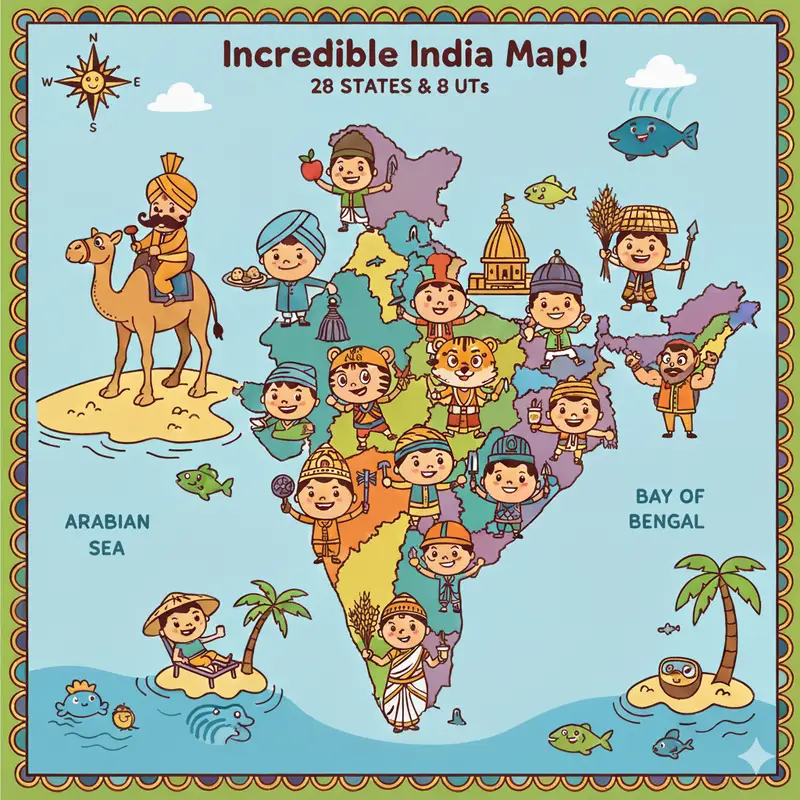Unseen Passage For Class 2 With Answers helps young learners, to an exciting journey through an unseen passage designed specifically for them. In this passage, we will embark on an enchanting adventure with a little girl named Maya as she discovers a magical garden filled with wonders and surprises. After reading the passage, you will have the opportunity to test your comprehension skills by answering a series of questions. So, let’s dive into the world of imagination and let the words transport us to a realm of beauty and magic!
Read the following Unseen Passage and answer the questions that follow.
Once upon a time, in a small village, there lived a little boy named Raju. He was very curious and loved exploring new things. One day, while playing near the river, Raju saw something shiny at the bottom. It was a small silver key. He picked it up and wondered what it could unlock.
Raju ran home excitedly and showed the key to his mother. His mother smiled and said, “Maybe it’s a magical key, Raju. Let’s find out what it unlocks!” Raju’s eyes widened with excitement.
Together, Raju and his mother searched the entire house, trying the key on every lock they could find. They tried it on the door, the cupboards, and even the old trunk in the attic. But nothing seemed to unlock with the key.
Just when Raju was starting to lose hope, his mother had an idea. She said, “Let’s go back to the river, Raju. Maybe there’s something there that needs unlocking.”
Raju and his mother hurried back to the river. As they reached the spot where Raju found the key, they saw a small wooden chest half-buried in the sand. They quickly dug it out and used the key to unlock it. Inside, they found a beautiful necklace made of shining pearls. Raju’s eyes sparkled with joy.
His mother hugged him and said, “You did it, Raju! The key unlocked something precious indeed. Remember, sometimes the greatest treasures are hidden in unexpected places.”
Questions:
- What did Raju find near the river?
- What did Raju do after finding the key?
- Did Raju’s mother believe the key was magical?
- Where did Raju and his mother find the wooden chest?
- What did they find inside the chest?
- How did Raju feel when he saw the pearls?
Answers:
- Raju found a small silver key near the river.
- After finding the key, Raju ran home and showed it to his mother.
- Yes, Raju’s mother believed the key was magical.
- Raju and his mother found the wooden chest near the spot where Raju found the key, half-buried in the sand.
- Inside the chest, they found a beautiful necklace made of shining pearls.
- Raju felt joyful and his eyes sparkled with joy when he saw the pearls.
Also Read: 7 Reasons Why Homophones are important for young learners – Definition, Usage and Examples
————————————————————————————————————————-
Unseen Passage – “The Busy Bee”
The bee is a small insect that is known for its hard work and diligence. Bees live in colonies and work together to collect nectar and pollen from flowers. They are always buzzing around, going from one flower to another, collecting food for themselves and their hive.
Bees have a special body part called a proboscis, which acts like a straw. They use it to suck up nectar from flowers. While collecting nectar, bees also collect pollen on their bodies. Pollen is a powdery substance that helps flowers make seeds. Bees unintentionally transfer pollen from one flower to another, which helps in the process of pollination.
Once the bees have collected enough nectar and pollen, they fly back to their hive. Inside the hive, there is a special area called the honeycomb. The bees store the nectar in the honeycomb, where it turns into honey. Honey is the food that bees eat, and they store it to use during the winter when there are no flowers to collect nectar from.
Bees are very organized and have different roles in their colony. There is a queen bee who lays eggs, worker bees who collect food and build the hive, and drone bees whose job is to mate with the queen bee. All the bees work together to keep the hive running smoothly.
Bees are important for the environment because they help in the pollination of flowers. Without bees, many plants would not be able to reproduce and grow. They play a vital role in the ecosystem and contribute to the diversity of plant life.
Questions:
- What is the bee known for?
- Where do bees live?
- What is the purpose of a bee’s proboscis?
- What is pollen?
- How do bees help in pollination?
- Where do bees store the nectar they collect?
- Why is honey important to bees?
- What are the different roles in a bee colony?
- Why are bees important for the environment?
- Name one thing bees help in the environment.
Answers:
- The bee is known for its hard work and diligence.
- Bees live in colonies.
- The purpose of a bee’s proboscis is to suck up nectar from flowers.
- Pollen is a powdery substance that helps flowers make seeds.
- Bees help in pollination by transferring pollen from one flower to another.
- Bees store the nectar they collect in the honeycomb.
- Honey is important to bees because it is their food source during the winter.
- The different roles in a bee colony are queen bee, worker bees, and drone bees.
- Bees are important for the environment because they help in the pollination of flowers, allowing plants to reproduce and grow.
- Bees help in the diversity of plant life.
————————————————————————————————————————-



